The 26/11 Mumbai attacks were a series of devastating terrorist strikes that began on the evening of November 26, 2008, and continued for over 60 hours. A group of 10 armed terrorists from the Pakistan-based group Lashkar-e-Taiba entered Mumbai by sea and launched coordinated strikes on prominent locations, targeting both locals and foreigners. The attacks left the city in shock and claimed hundreds of innocent lives.
Over the course of four days, the city was under siege as the attackers targeted prominent locations in South Mumbai, including the Taj Mahal Palace Hotel, Oberoi Trident Hotel, Chhatrapati Shivaji Maharaj Terminus (CSMT), and Nariman House.
The first strikes occurred at Chhatrapati Shivaji Terminus (CST), a busy railway station, where two gunmen opened fire on passengers, killing and injuring many. Simultaneously, shootings erupted at the popular Leopold Cafe and attacks unfolded at the luxurious Taj Mahal Palace Hotel and the Oberoi-Trident Hotel, where hostages were taken and parts of the buildings were set on fire. Another group of terrorists targeted the Nariman (Chabad) House, a Jewish community centre, taking hostages and engaging in a deadly standoff.
Indian security forces, including the National Security Guard (NSG) commandos, launched a massive operation to rescue hostages and neutralise the attackers. By the time the siege of Mumbai ended, 166 people were killed and over 300 were injured. One of the terrorists, Ajmal Kasab, was captured alive, providing critical evidence about the attackers and their plans.
The 26/11 attacks deeply impacted Mumbai and the nation. Today, we remember those who lost their lives and honour the sacrifices of those who risked everything to protect the city. Their courage continues to inspire and reminds us of the strength in unity and endurance against terror.
The memory of the 26/11 attacks continues to be honoured annually, not only remembering the lives lost but also the heroism displayed by those who fought to protect others.
The first place where the attack occurred was Chhatrapati Shivaji Maharaj Terminus. Ajmal Kasab along with his men, opened fire on passengers at the station. The attack led to the death of 58 people and 100 people got injured.
One of the most popular cafes, Leopold Cafe, became the target of the terrorists. The cafe was filled with locals and tourists when attackers started shooting aimlessly. This marked the beginning of the most extensive siege during the attacks.
The Taj Mahal Palace Hotel became the primary target of the attackers. The hotel was filled with guests and staff, many of whom were trapped inside. As the attackers held the hotel under siege, fire and smoke were seen from the upper floors creating a scene of chaos and horror. The armed terrorists attacked the hotel and guests and staff were taken hostages.
The second hotel under siege was the Oberoi Trident where gunfire in the lobby and hallways could be seen. The attackers held hostages and fired on hotel staffs and guests. Guests were trapped inside their rooms as the gunmen were roaming in the building. Explosions and gunfire erupted inside, adding to the terror of the night.
The attackers also seized Nariman House, a Jewish community centre. Two hostages, a Rabbi and his family, were killed during the attack. The battle between commandos and terrorists lasted for hours. The centre became a focal point of the international aspect of the tragedy, as it involved foreign nationals.
Indian police, including the Anti-Terrorism Squad (ATS), rushed to the scene. Up to 18 security personnel were killed in the attack. Among the first responders was Hemant Karkare, the ATS chief, who lost his life during the attack. His bravery symbolised the courage of many officers who risked their own lives to save others.
The National Security Guard (NSG) commandos, India’s counter-terrorism unit, arrived in Mumbai. The city was lit up with flames and gunfire as the commandos began their attacks on the Taj and Oberoi hotels, aiming to neutralise the terrorists and free the hostages.
Indian security forces attempted to rescue the hostages. The attackers continued to hold portions of the Taj and Oberoi hotels, while negotiations with the terrorists were attempted. After a 60-hour siege, the NSG commandos entered the two hotels and neutralised the terrorists. In total, nine of the 10 attackers were killed during the operations, and one, Ajmal Kasab, was captured alive. Hostages were freed as commandos worked tirelessly to neutralise the terrorists, rescuing survivours and bringing them to safety.
Over 170 people were killed, including 18 security personnel, and more than 300 were injured. The tragic loss of life, along with the attack on foreign nationals, sparked outrage worldwide.
Ajmal Kasab’s trial and subsequent execution in 2012 brought some closure, but the attack left deep scars on the city and its people.
People came together in unity, lighting candles, holding memorials, and honouring the victims. The city’s spirit remained unbroken, proving that terrorism could not defeat the heart of Mumbai. The city mourned the loss of over 170 lives. Public tributes were held at various locations, including CST, the Taj, and other memorials across the city. The event changed the city forever and led to a reevaluation of India’s counter terrorism strategies.
Link to article –
